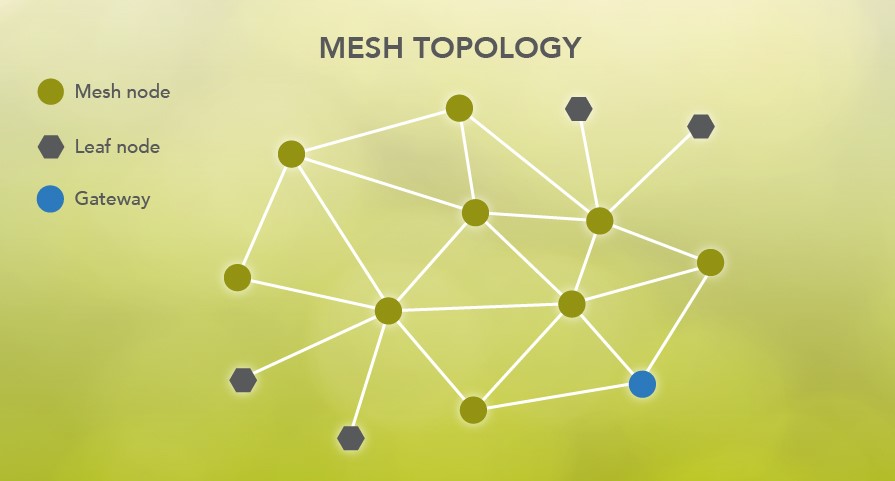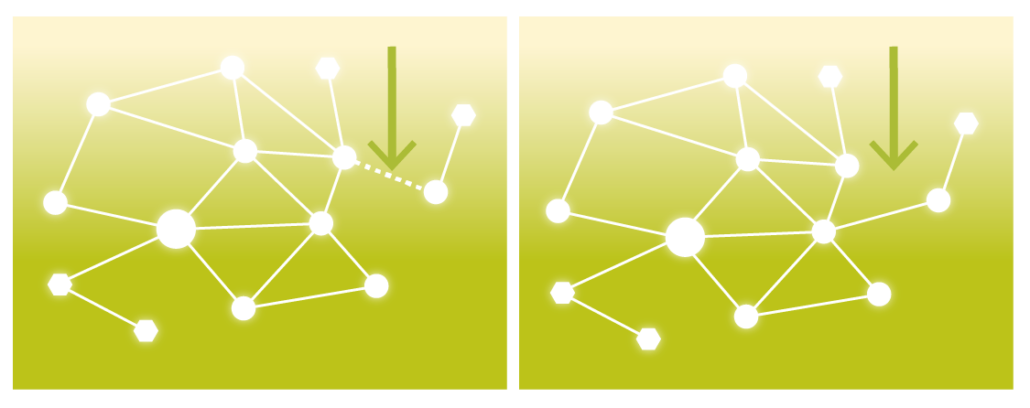Summary
Wireless mesh networks are a type of network where the devices themselves create the coverage and help to forward the data to its destination, eliminating the need for a separate infrastructure and so reducing cost and complexity.
Since data is forwarded from node to node, the range of an individual device becomes less important, as that range now does not have to encompass all devices, but only a subset of them.
Wireless mesh networks can be self-healing, meaning that if the currently used path through the mesh is disrupted (for example due to a device failure or because of a change in the installation environment), the network will find a new route for the traffic. This helps the network to be future-proof, adapting to changes made.
The source for this article comes from one written by Michael Karlsson of LumenRadio and describes the type of mesh network that is used by the Enlight Collect IMx-1 system.
8 THINGS YOU SHOULD KNOW ABOUT WIRELESS MESH NETWORKS
March 12, 2020 written by Michael Karlsson, LumenRadio
Note that the article contains links to further information pages on the LumenRadio website.
In the context of the Enlight Collect IMx-1 system, a system comprises an CMWA 6600 Enlight Collect Gateway (termed gateway device below) and CMWA 6100 Enlight Collect IMx-1 sensors (fulfilling the mesh and leaf roles described in the article). Note that in an IMx-1 system the sensor can be configured as either a mesh, relay or leaf device. Both mesh and relay contribute to the mesh (and fall in the 'mesh category' described below) with the difference that for a relay node this is its sole purpose and it doesn't also make any measurements.
Details
Wireless mesh is a crucial part of successful IoT (Internet of Things) applications. But what is wireless mesh, what are the advantages of a wireless mesh network and how can your product benefit from this? Here are the 8 things you need to know.
- WHAT IS A WIRELESS MESH NETWORK?
A wireless network is an infrastructure made up of devices that are wirelessly coupled to each other. The devices help forwarding packets so that the network can cover a larger area without the user needing to think about setting up a dedicated infrastructure.
It is safe to say that wireless mesh networks will be the steppingstone for IoT (Internet of Things) rollout. Without wireless mesh networks, it would just be too expensive to roll out massive scale networks in entire buildings.
- WHAT TYPE OF DEVICES ARE THERE IN MESH NETWORKS?
Different technologies have different nomenclature, but usually there are three main types of devices;
1. Gateways or border routers
2. Mesh devices or routers
3. Leaf devices
A border router, or a gateway, is the interface to the outside world, they may connect the wireless mesh network to a building Ethernet, or connecting to a cloud service via Internet, for instance via LTE or 3G.
A mesh device is a device that helps build up the actual mesh. They forward, or route, data to and from other nodes hence being the mesh backbone.
Leaf devices are devices that are part of the mesh network, but they do not help creating the infrastructure. They do not forward traffic on behalf of others, but they can communicate via the network. Leaf devices are often devices that need to conserve energy due to constraints on battery. - WHAT DOES SELF-HEALING MEAN?
A wireless mesh is self-healing if it can automatically repair itself when the environment changes. It could for instance be that a link between two nodes that worked perfectly fine an hour ago is now blocked by a bookshelf, a truck, or a steel door. The network will then automatically, without the involvement of any user, change its topology to be able to route the traffic a different path.
- WHAT IS IPV6 AND 6LOWPAN?
IPv6, or Internet Protocol version 6, is the most recent version of the Internet Protocol. It became a draft standard in 1998 and is intended to replace the commonly used IPv4 protocol. IPv6 allows for a much larger address space with approximately 3.4×1038 unique addresses. 6LoWPAN, or IPv6 over Low-power Personal Area Networks, is an adaptation layer that allows for the use of IPv6 in wireless mesh networks and other types of networks that are more constrained than Ethernet and WiFi. By selecting a wireless mesh network that uses IPv6 you gain the possibility to use standard Internet protocols for many different applications, such as security systems, messaging protocols for sensors, etc. - CAN WIRELESS MESH NETWORKS BE BATTERY POWERED?
They certainly can! MiraOS offers unprecedented energy efficiency – allowing for fully connected mesh devices to run from a single battery for many years, even decades.
Not all wireless mesh networks are suitable for battery operation though, and some allow certain devices to be battery operated – while still requiring the majority of devices to have hard-wired power. You can read more about low energy mesh technology on our Knowledge page. - ARE WIRELESS MESH NETWORKS SECURE?
Rest assured that most wireless mesh networks indeed are secure. Mira networks uses strong AES encryption in the link-layer between devices with protection for eavesdropping, replay-attacks, etc. IPv6 based wireless mesh networks, such as Mira, also support end-to-end security mechanisms with banking-class cryptography. New vulnerabilities and attacks are discovered from time to time; hence it is important that the mesh technology you choose supports over-the-air software updates to roll out security updates when they are needed. - IS THERE A STANDARD?
There are many standards. Very few of them are compatible with each other. However, when using a wireless mesh technology that uses IPv6 and 6LoWPAN, you can rest assured that your application can be compatible with any Internet protocol based standard – just a word of caution: some protocols are more lightweight than others, making them more suitable for wireless mesh networks, one such standard is LWM2M specifically designed to work from the tiniest device via Internet, to the cloud if needed. Other IP based protocols that can be used are CoAP, MQTT-SN, etc. You can read more about wireless standards on our Knowledge page. - IS IT EASY TO INSTALL?
It can be – if you select a wireless mesh stack where this has been an important design criterion. At LumenRadio, with our MiraOS, you can make deployment easy using a standard smartphone from an app, either using Bluetooth for remote commissioning, or via NFC for touch-to-commission.
Contacting SKF Technical Support Group
For further assistance please open a support case using the Technical Support group's self-help portal at www.skf.com/cm/tsg. Once your support case is submitted, a technician will contact you to begin working on your issue. For urgent issues we are available at these times by phone:
- Monday through Friday, 5:00 a.m. to 4 p.m. Pacific Time -
Phone: +1 800 523 7514 within the US or +1 858 465-4510 outside the US. - Monday through Friday, 8:00 a.m. to 4:00 p.m. Central European Time -
Phone: +46 31 337 65 00. - Monday through Friday, 7:30 a.m. to 4:30 p.m. India Standard Time -
Phone: +60 16 699 9506.
Comments
0 comments
Please sign in to leave a comment.